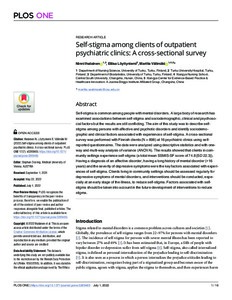Self-stigma among clients of outpatient psychiatric clinics: A cross-sectional survey
Ihalainen Ninni; Löyttyniemi Eliisa; Välimäki Maritta
Self-stigma among clients of outpatient psychiatric clinics: A cross-sectional survey
Ihalainen Ninni
Löyttyniemi Eliisa
Välimäki Maritta
Public Library of Science
Julkaisun pysyvä osoite on:
https://urn.fi/URN:NBN:fi-fe2022091258566
https://urn.fi/URN:NBN:fi-fe2022091258566
Tiivistelmä
Self-stigma is common among people with mental disorders. A large body of research has examined associations between self-stigma and sociodemographic, clinical and psychosocial factors but the results are still conflicting. The aim of this study was to describe self-stigma among persons with affective and psychotic disorders and identify sociodemographic and clinical factors associated with experiences of self-stigma. A cross-sectional survey was performed with Finnish clients (N = 898) at 16 psychiatric clinics using self-reported questionnaires. The data were analyzed using descriptive statistics and with one-way and multi-way analysis of variance (ANOVA). The results showed that clients in community settings experience self-stigma (a total mean SSMIS-SF score of 74.8 [SD 22.3]). Having a diagnosis of an affective disorder, having a long history of mental disorder (>16 years) and the severity of depressive symptoms were the key factors associated with experiences of self-stigma. Clients living in community settings should be assessed regularly for depressive symptoms of mental disorders, and interventions should be conducted, especially at an early stage of the illness, to reduce self-stigma. Factors associated with self-stigma should be taken into account in the future development of interventions to reduce stigma.
Kokoelmat
- Rinnakkaistallenteet [27094]
